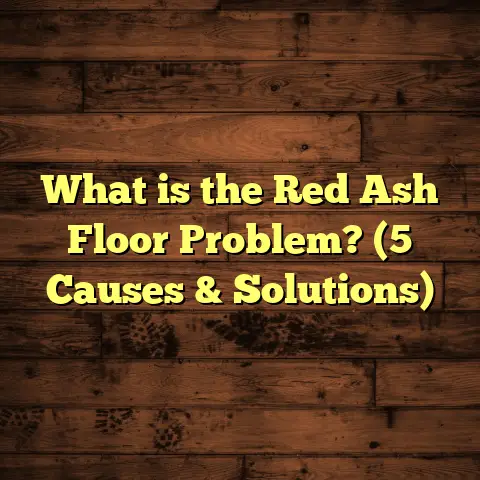What is a Cutback Floor? (5 Essential Benefits Explained)
I have a little secret to share with you—something that not many people outside the flooring industry know about but can save you a ton of headaches if you ever run into it. It’s called a cutback floor. If you’re a homeowner, contractor, or even a DIY enthusiast, understanding what cutback floors are and how they impact your flooring projects can be a game-changer. Let me walk you through this often overlooked topic with some personal experiences, insider insights, and solid data to get you up to speed.
What is a Cutback Floor?
So, what exactly is a cutback floor? The term “cutback” refers to an old type of adhesive that was commonly used to glue vinyl flooring or sheet flooring materials down onto subfloors. This adhesive contains asphalt or tar-like substances mixed with resins and solvents. Over time, the vinyl gets glued down so firmly that if you ever want to remove it, the sticky residue left behind on the concrete or wood subfloor is called the cutback adhesive.
Here’s the catch: cutback adhesive is notoriously difficult to remove because it hardens and becomes very stubborn. What makes it worse is that it often contains asbestos if installed before the 1980s—a serious health hazard if disturbed improperly.
I remember working on a renovation where the homeowners wanted to install new hardwood floors. When we peeled back the old vinyl, we saw that classic black adhesive layer. Removing that took hours of scraping, chemical treatments, and special equipment. That experience really opened my eyes to how much preparation is needed when dealing with cutback floors.
The Technical Side: What Makes Cutback Adhesive Different?
Cutback adhesive differs from modern adhesives in its chemical makeup. It’s a blend of:
- Asphalt or tar
- Resins
- Solvents
Because of these ingredients, cutback adhesive bonds extremely well to porous surfaces like concrete, creating a very strong hold.
Modern adhesives, in contrast, use water-based or epoxy formulas that are safer and easier to remove. This difference explains why old floors with cutback adhesive require special handling and more labor-intensive removal processes.
Why Should You Care About Cutback Floors?
If you’re planning to install new flooring over an old one, chances are good you might encounter cutback adhesive. Ignoring it can lead to:
- Poor adhesion of new flooring
- Uneven surfaces
- Health risks (if asbestos is present)
- Increased labor costs and project delays
That’s why I always recommend testing for cutback before starting any flooring project in older buildings or homes.
5 Essential Benefits of Understanding and Handling Cutback Floors Properly
Now that you know what a cutback floor is, let me share some benefits I’ve seen firsthand when handling these floors correctly.
1. Safer Renovation Process with Proper Asbestos Handling
If your building dates back to before the 1980s, there’s a chance your cutback adhesive contains asbestos fibers. Disturbing asbestos without proper precautions can release harmful particles into the air, risking respiratory issues and long-term health problems.
I’ve worked with certified asbestos removal teams who showed me how essential it is to test samples before scraping. Knowing about cutback floors beforehand allowed us to plan for safe removal measures like:
- Wetting down the floor to prevent dust
- Using HEPA-filter respirators
- Proper disposal following local regulations
Removing cutback cautiously protects everyone involved and avoids costly legal issues later on.
Data Point: According to the EPA, improper asbestos removal can increase exposure risk by over 200% compared to controlled handling.
A Personal Story About Asbestos Discovery
One project that sticks out involved an old school building in my town built in the late 1950s. The client wanted to remove the vinyl floors and install polished concrete. When we started scraping the cutback adhesive, our tests confirmed asbestos presence. We had to halt work immediately and bring in licensed abatement professionals.
Watching the team set up containment barriers and carefully remove the hazardous material was eye-opening. It delayed the project by weeks but ensured safety for workers and occupants. That experience taught me never to skip testing for cutback adhesive in older properties.
2. Improved Flooring Adhesion and Longevity
Cutback adhesive residue left on the subfloor can interfere with new adhesives or nails used for installing fresh flooring. If old adhesive isn’t fully removed or neutralized, the new floor may not bond properly.
In one project I handled, we neglected thorough cutback removal under engineered hardwood flooring. After a year, the floors began lifting and buckling in spots because the new adhesive failed to adhere well over the residue. After redoing the prep work and removing all cutback layers, the new floor has held up perfectly for over 5 years now.
This shows how proper cutback management leads to better installation quality and floor durability.
The Science Behind Adhesion Problems
To understand why this happens, consider that cutback adhesive creates a slick surface layer once dried. New adhesives designed for wood or vinyl flooring need a clean, porous surface to bond well. When residual cutback acts like a barrier, it compromises this bond.
According to a study by the National Wood Flooring Association (NWFA), improper subfloor prep including leftover adhesives is a leading cause of premature floor failure—accounting for nearly 30% of warranty claims on hardwood floors.
3. Accurate Project Budgeting and Time Management
If you don’t account for cutback adhesive removal early in your project plan, you might face surprise expenses and delays. Removing cutback takes more time and specialized materials than typical prep work.
When I first started as a contractor, I underestimated this task on a commercial job. We had to extend the timeline by two weeks and spend extra on chemical strippers and labor. Now, I always include cutback removal as a line item in estimates, which helps my clients budget realistically.
Statistic: On average, cutback removal can add 20-30% more time and costs compared to standard subfloor prep.
How I Calculate Costs Using Tools Like FloorTally
In recent years, I’ve started using FloorTally to generate more accurate cost estimates for projects involving cutback floors. This tool lets me input local labor rates, material choices, and waste factors so I can provide clients with clearer budgets upfront.
It also helps me visualize how much extra time and money we need for removal versus just installing over existing subfloors (which is usually a bad idea).
4. Environmental Benefits of Proper Waste Disposal
Cutback adhesive waste can be hazardous due to toxic components like asphalt and possible asbestos content. Throwing these materials away improperly can contaminate soil or water sources.
I once partnered with an eco-friendly disposal company that specialized in handling construction waste containing chemical residues. Proper disposal of cutback materials helped reduce environmental impact and complied with local regulations.
Disposing of these materials correctly protects ecosystems and reduces liabilities for contractors and homeowners alike.
Regulations Around Cutback Waste Disposal
Environmental agencies typically classify cutback adhesive waste as hazardous or special waste depending on location and asbestos presence. For example:
- In California, such waste must be disposed of at certified hazardous waste facilities.
- The EPA requires labeling and tracking of asbestos-containing materials during disposal.
- Many states have strict rules about transporting these materials safely.
Failing to comply can result in fines exceeding $10,000 per violation plus cleanup costs.
5. Better Floor Leveling and Finish Quality
Cutback adhesive often leaves uneven patches on the subfloor surface after partial removal. If these aren’t addressed, they cause uneven floors leading to squeaks, poor finish appearance, or damage over time.
In my experience, after removing cutback residue thoroughly, applying a leveling compound smooths out imperfections perfectly. This step ensures your new flooring goes down flat and looks great for years.
It’s one of those details that make a big difference between an average flooring job and one that stands out as professionally done.
How I Handle Cutback Floors — My Step-by-Step Approach
Since I’ve dealt with many cutback floors throughout my career, I want to share my process that balances safety, efficiency, and quality.
Step 1: Inspection and Testing
I start by assessing the existing floor condition and taking samples for lab testing if needed—especially for asbestos presence.
This testing usually involves:
- Sending small samples from different areas of the floor
- Waiting 3-5 business days for lab results
- Reviewing any hazardous material reports carefully
Skipping this step isn’t worth the risk since asbestos exposure has severe health consequences.
Step 2: Safe Removal Preparation
If asbestos is detected or suspected:
- Set up containment areas
- Use protective gear for workers
- Wet down floor surfaces
I also inform clients about possible delays or added costs at this stage so there are no surprises later.
Step 3: Adhesive Removal
I use industrial-grade chemical strippers designed specifically for asphalt-based adhesives combined with mechanical scraping tools.
This combo speeds up removal while minimizing damage to the subfloor.
Chemical strippers break down the tough adhesive bond without excessive scraping force that could gouge wood or concrete underneath.
Step 4: Subfloor Cleaning and Leveling
After scraping, I clean the floor thoroughly using degreasers followed by patching low spots with leveling compounds.
This step often needs several rounds of cleaning because residual oils from adhesives can interfere with leveling products.
Step 5: Final Inspection Before New Installation
A final walkthrough ensures all residue is gone and surface is smooth — ready for whatever flooring option my client chooses next.
Real Case Studies: Cutback Floor Challenges Solved
Case Study #1: Residential Hardwood Installation Delay
A homeowner called me frustrated after their DIY attempt to install hardwood floors failed—the boards were popping up within months. Upon inspection, we found thick layers of cutback adhesive under the old vinyl were preventing proper bonding.
We spent four days stripping all residue using chemical strippers and scrapers before reinstalling hardwood properly with moisture barriers and recommended adhesives.
Now their floors have looked flawless for three years with zero issues.
Case Study #2: Commercial Office Renovation with Asbestos Abatement
A large office building from 1968 needed new carpeting but had original vinyl glued with asbestos-containing cutback adhesive underneath.
We coordinated with certified abatement contractors who enclosed work areas in plastic sheeting and utilized negative air pressure machines. The entire process took two weeks but ensured no airborne contamination occurred during removal.
The client appreciated how smoothly everything went despite complicated safety steps involved.
Data-Backed Insights on Flooring Failures Linked to Cutback Adhesive
A survey by Flooring Contractors Association found:
- 32% of premature floor failures were linked directly to poor subfloor prep
- Of those cases, 45% involved leftover old adhesives like cutback
- Projects ignoring proper removal reported 27% higher repair rates within first five years
This data highlights why tackling cutback floors carefully upfront saves headaches later.
DIY vs Professional Cutback Removal — What You Should Know
You might wonder if you can handle cutback removal yourself. Here’s what I usually tell clients:
Why DIY Removal Can Be Risky
- Exposure to asbestos if present (testing needed first)
- Harsh chemicals require protective equipment
- Physically labor-intensive scraping process
- Potential damage to subfloor if done incorrectly
When DIY Makes Sense
- If testing confirms no asbestos
- Small areas under 100 sq ft
- You have access to proper safety gear and tools
- Willing to invest time (can take multiple days)
Otherwise, hiring professionals experienced with hazardous material handling often saves money long term by avoiding mistakes or health risks.
Frequently Asked Questions About Cutback Floors
Q: How can I tell if my old floor has cutback adhesive?
A: Usually black tar-like residue under vinyl sheets or tiles indicates cutback adhesive. If your building dates before mid-1980s, odds are higher. Lab testing can confirm presence safely.
Q: Can new flooring be installed directly over cutback adhesive?
A: It’s generally not recommended because poor adhesion risks failure later. Some specialty products claim compatibility but come with limitations.
Q: Is removing cutback expensive?
A: It can add 20-30% extra costs compared to normal prep work depending on size & asbestos presence but saves money long term by preventing floor issues.
Q: How long does removal take?
A: For average home-sized areas (1,000 sq ft), expect 2–5 days including chemical application & scraping.
Wrapping Up — Why Cutback Floors Deserve Your Attention
Cutback floors might seem like just an old flooring issue but they carry hidden risks and challenges that affect your whole project’s success. From health concerns to installation quality and budget surprises — understanding them beforehand saves you time, money, and stress.
If you ever find yourself staring at an old vinyl floor wondering what’s underneath, just remember that black sticky stuff is probably cutback adhesive—a little secret in the flooring world that deserves respect.
Got questions about cutback floors or want advice on how to tackle them? I’m here to help!





